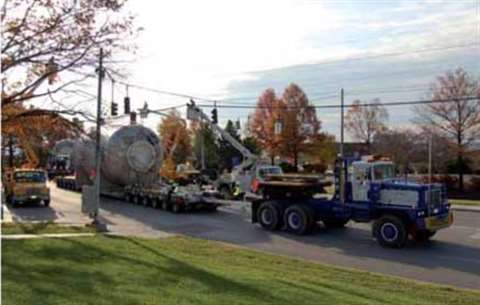Permit challenge
20 March 2008

The task of Edwards Moving ' Rigging in the US was to transport simultaneously two oversized and over dimensional 150,000 pound (68 tonne) polymerisation reactors from a manufacturing plant 24 miles (38 km) through the very narrow and busy streets of Cincinnati, Ohio to a barge site where they were loaded and shipped to a chemical plant in Louisiana.
The initial planning meeting for the transport project was conducted in August 2006 with support companies in attendance. The primary focus of the first meeting was to discuss the obstacles and begin planning the logistical activities of this transport, including safety measures to address issues related to traffic control, emergency preparedness and obstructions with overhead utilities and transport routes.
At 5:30 a.m. on 5 November the project began with a safety meeting to review the plan and go over anticipated hazards. The transport of the two reactors ended at the barge site at 6 p.m. The units were loaded on the barges the following day for their river transport.
Among the biggest challenges of this project was to secure permits for travel through the city of Cincinnati, the county of Hamilton and the state of Ohio. It was very clear from the beginning that securing permits with these regulatory agencies would be a monumental task, especially with all the special conditions, including the disruption of traffic, the fragile nature of bridges, travelling across a major interstate and railroad lines, the fragile infrastructure of traffic signals and overhead utilities and the like.
Edwards was responsible for overseeing and managing both loads, and provided the customer with a flat rate price for the entire scope of the project. This included providing the crew and the equipment and overseeing the loading of the pieces onto their transporter at the onset of the move.
Each 150,000 pound reactor was 35 feet 9 inches long and 18 feet 9 inches wide (10.9 x 5.7 m). They were 17 feet 6 inches tall (5.3 m). The total gross permitted weight of each reactor was 343,320 pounds (156 tonnes). A part of the project for Edwards was to design and fabricate four saddles for the purpose of securing the loads on the trailer as well as to use them for loading and securing them on the barge.
To transport the reactors Edwards used its prime movers, each pulling the loads on a six-deck, six-line configuration - six lines of Goldhofer trailer, a Goldhofer step deck and six lines of Goldhofer trailer. The hauls were done simultaneously to maximise the availability of all the support agencies involved and the configuration was chosen in order to navigate the narrow streets and tight turns as well as the height of the reactors. This transport configuration was designed to keep the load low to the ground to best manage the thousands of overhead utility lines along the route. The configuration was also deemed the safest mode of transport. Due to narrow streets, the transport would take up 1½ lanes along much of the route.
For the loading phase AmQuip provided a 550 ton (500 tonne) capacity all terrain crane and a spreader bar with two basket slings. The reactors were lowered onto stools where they were secured onto a dedicated barge and tug boat for final transport to Louisiana.
The 24 mile route was on some of the busiest and narrowest streets of Cincinnati and included some very steep hills including 10 to 12 degree grades and curvy streets. There were bridges to cross, a major interstate to follow and railroad crossings as well. One very old and fragile city bridge had to be “jumped” using the ramp on and off exits as a means to get around it. Numerous power lines had to be raised so the transport speed ranged between three and 10 miles per hour (5 to 16 km/h).
This project required hundreds of hours of pre-planning in engineering and safety. There was analysis of roadways and almost a dozen different entities to deal with. There was even an aggressive public awareness campaign to alert the general public of possible delays and alternative routes to take on the day of the move.
Traffic lights needed to be raised so Edwards had to obtain a $10,000 bond to cover any related damages to signal lights during the move. All of the regulatory agencies raised major concerns about the fragile nature of these traffic lights so Edwards chose the bond as a way to assure their cooperation.






